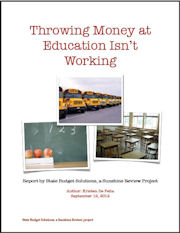 Read the title of a new study by State Budget Solutions, “Throwing Money at Education Isn’t Working,” and you’ve read the main conclusion: Higher spending does not guarantee better student performance.
Read the title of a new study by State Budget Solutions, “Throwing Money at Education Isn’t Working,” and you’ve read the main conclusion: Higher spending does not guarantee better student performance.
In 2010, the United States spent $809 billion on K-12 education, which represented twice as much per pupil as the nation spent in 1970. We spend more on schools than peer nations yet American students have lower standardized test scores. (Virginia, incidentally spent 34.9% of its General Fund budget on K-12 in 2009, the fourth highest percentage in the nation.)
The report, authored by Kristen de Peña, makes the case that there is little correlation between how much money a state spends on schools and the results those schools deliver. That’s not to say that money isn’t a factor. It’s just that so many other factors affect student performance that it’s easy to spend added funds unproductively. She is also skeptical of other commonly proffered panaceas such as charter schools and performance-based standards. “In the ten years since No Child Left Behind became law,” she writes, “it is clear that one-size-fits-all testing, sanctioning under-performing schools and rewarding high-performing schools, undermines actual education efforts.”
The solution? More decentralization. “Educators and elected officials need to look at what is working in various states with high ACT scores and graduation rates. What they will see is that states taking a more active role in educational outcomes produce better performance results. Taking a more active role in education includes developing flexible, practical education plans tailored to state students or prioritizing school district transparency to minimize waste and fraud.”
Bacon’s bottom line: The social science of education is so complex, so plagued by inadequate data and so polarized by ideology that I question whether anyone can decipher what is needed to turn schools around. My sense is that the system needs to be reinvented from the ground up. I question fundamental assumptions: that students should be organized in age cohorts and herded lockstep through entities called “schools.” No one-size-fits-all solution will work. Education should be tailored to the needs and aptitudes of individual children. The bureaucratic, government-run structures we have erected are incapable of making the change. It’s time for radical experimentation. For a glimpse of the future, look to home schooling and online education.
— JAB


